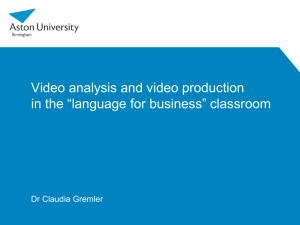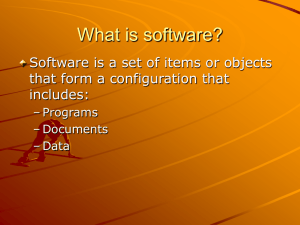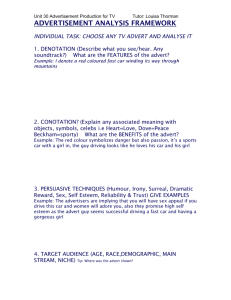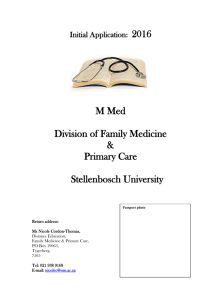The benefits of video production tasks as language learning activities
advertisement
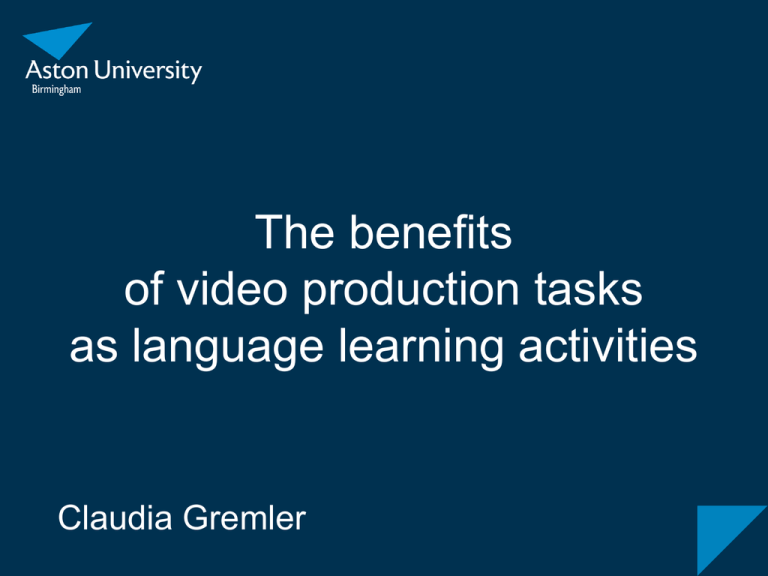
The benefits of video production tasks as language learning activities Claudia Gremler The use of video in the foreign language classroom Why do we use it? How do we use it? How do students react to it / benefit from it? Does its use cater to the needs of the media literate "modern student"? „His teachers use technology as an event. Outside of school, he doesn’t separate technology from other activities. For him, it is air or water, something that he doesn’t really think about because it’s always available.“ http://smartblogs.com/education/2012/06/29/snapshot-modernlearner/ Why use video in the foreign language classroom? To train students’ listening skills To add an audio-visual experience for the students and provide an alternative or addition to written materials To facilitate cultural learning by giving students a multimedia insight using authentic materials featuring native speakers To provide input for group discussions To impart/acquire background knowledge For self-study activities Why use video in the foreign language classroom? To train students’ listening skills To impart background knowledge (CLIL) (most popular uses amongst language teaching staff at Aston University) Most colleagues source video online and do not edit it! What are the benefits from the student perspective? These are statements which the majority of students agreed with: "Visual media helps me understand things better" "I find it easier to concentrate when visual media are used in the classroom“ "The use of visual media provides a more authentic access to the foreign culture" "It is important that visual media are accompanied by tasks and activities" Research questions What are beneficial video based activities? What kinds of video based activities are students familiar with? And are they successful? (i.e. do they produce a good learning experience?) What new activities can be developed and introduced and how can they be integrated into the curriculum? Research questions What constitutes a succesful learning process? Which types of activities can be used to ensure a successful learning process? Video based activities Students were familiar with a wide range of video based learning activities (listening exercises, group discussions, role play, written content questions, grammar exercises, film/media analysis etc.) They had also previously used many different types of video in their learning acitivities (documentaries, news programmes, soaps, feature films, shorts, adverts, music videos etc.) Only very few students had tried creative acitivites such as dubbing or producing their own videos Video and the learning process Learning can be seen as a constructivist process (knowledge construction rather than knowledge transmission) which needs be guided through adequate scaffolding should be contextualised (organised around authentic meaningful tasks) The learning activities should also encourage the learner to be active contain collaborative elements that ensure interaction be emotionally involving and motivating. Karpinnen 2005; Masats/Dooly/Costa 2009 Video production and language learning To ensure that video production tasks foster a successful learning experience, two methodological approaches are particularly condusive: CLIL (Content and Language Integrated Learning) to integrate the construction of linguistic and nonlinguistic knowledge PBL (Project-based Learning) to connect the learning process to students‘ own lives through emotionally and intellectually engaging tasks (Masats/Dooly/Costa 2009) Video Production in Language Learning http://divisp roject.eu/int roduction Video production tasks in LTS (Languages and Translation Studies) at Aston University Pioneering activities in Spanish: Video CVs / diaries / film portraits of other students (levels 4, 5 and ab initio learners) (not assessed) Video project in level 6 core language module: short feature / drama students write their own script (the script is assessed, not the video) (20% of 20 credits) equipment and technical support available in the department and in the Centre for Learning Innovation and Professional Practice (CLIPP) Video production in language learning http://divisp roject.eu/int roduction Video production tasks for IBML (International Business and Modern Languages) students IBML is a successful four-year BSc programme at Aston, taught jointly by the School of Languages (LSS) and the Business School (ABS) It is a fully integrated business and language degree using the CLIL approach. All "German for Business" modules (core language modules) contain a business project (worth 20% of the module mark). In level 5, all students work on an intercultural marketing group project. The Marketing Project on "German for Business II" Students are given a popular German (or Austrian) food product not currently available in the UK. They are asked to design a marketing campaign for the introduction of the product in the British market and pitch it to “representatives” from the producing company. Marketing theory is covered in class. Overall weighting of the project: 20% of a 20 credit module. This is a very popular element of the module. New element: the filming of an advert for the product (as part of the pitch). Adverts In an early stage of the project students study a German advert with intercultural content (Wagners American Pizza) in both the German and Austrian version: http://www.youtube.com/watch?v=mQktvsomrC8 http://www.youtube.com/watch?v=ngmX0LwuLo0 Equipment and technical support The students use flip cams to record their video and VideoPad for editing A brief written guide to the filming is available on the Aston intranet Technical support and advice on basic filming principles is available from the Learning & Teaching Support team in LSS Learning technicians in CLIPP Sample products Student feedback was extremely positive overall. Possible concerns: How much language practice is actually involved? How time consuming is it to produce the advert? -> Is the low weighting justified? Do students acquire useful skills? “Making an advert helped me develop/practice useful skills” “Producing an advert helped me engage with the project” “This is not a beneficial activity for a language module” “Producing an advert is a feature of the marketing project that should be retained” Student Comments “It was as fun as it was educational.” “Producing the advert added more value to the project and although it took quite a bit of time to produce it was thoroughly enjoyable and as a result I enjoyed the project as a whole more than I think I would have done without this element. It is something that really engaged us to work on the project.” “I found that making the advert as a group helped us work better together and combine ideas in a productive way. I think it also made us more enthusiastic about the project and presentation.” “The advert should continue to be part of the marketing project. It is very interesting and it motivates the group to work well on the project.” Examples of Student Work https://dl.dropbox.com/u/17365751/Fizz%20Ahoy%20%20Medium.m4v https://dl.dropbox.com/u/17365751/Eierstich%20Werbespot%2 0untertitelt%201.wmv http://www.youtube.com/watch?v=_VReMs91JOU Results and implications A second video production project with a different group of level 5 learners also received positive feedback but was less successful overall. Results and implications Students experienced all the previously noted positive learning effects (also evidenced by Coleman 1992): active engagement (involving, motivational) confidence building collaborative (team building) Results and implications The secret of success? This project ticks all the boxes that were previously outlined: adequate scaffolding (theory presentations) and technological support motivational and engaging ("fun") contextualised and part of a meaningful and authentic task embedded in both CLIL and PBL approaches effort involved and "gain" appear to be well balanced Conclusion The success of the project demonstrates that benefits are to be gained from using video production in the foreign language classroom emphasises how important it is to create the right kind of learning environment and find a suitable embedding for such a task to succeed




